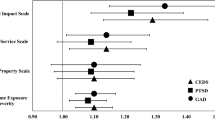Abstract
Estimates of acute mental health symptoms in the general population after disasters are scarce. We assessed the prevalence and correlates of acute posttraumatic stress disorder (PTSD) in residents of Manhattan 5–8 weeks after the terrorist attacks of September 11, 2001. We used random-digit dialing to contact a representative sample of adults living in Manhattan below 110th Street. Participants were interviewed about prior life events, personal characteristics, exposure to the events of September 11th, and psychological symptoms after the attack. Among 988 eligible adults, 19.3% reported symptoms consistent with PTSD at some point in their life, and 8.8% reported symptoms consistent with a diagnosis of current (within the past 30 days) PTSD. Overall, 57.8% of respondents reported at least one PTSD symptom in the past month. The most common past-month symptoms were intrusive memories (27.4%) and insomnia (24.5%). Predictors of current PTSD in a multivariable model were residence below Canal Street, low social support, life stressors 12 months prior to September 11th, perievent panic attack, losing possessions in the attacks, and involvement in the rescue efforts. These findings can help guide resource planning for future disasters in densely populated urban areas.
Similar content being viewed by others
References
McCarthy M. USA talks of war after more than 5,000 killed in terrorist attacks. Lancet. 2001;358:939.
Dead and Missing. New York, NY. New York Times. December 26, 2001; sect B:2.
Hidalgo RB, Davidson JRT. Posttraumatic stress disorder: epidemiology and health-related considerations. J Clin Psychiatry. 2000;61(suppl 7):5–13.
Green BL, Lindy JD. Post-traumatic stress disorder in victims of disasters. Psychiatr Clin North Am. 1994;17(2):301–309.
Galea S, Ahern J, Resnick H, et al. Psychological sequelae of the September 11 terrorist attacks in New York City. N Engl J Med. 2002;346:982–987.
Lavrakas P. Telephone Survey Methods: Sampling, Selection, and Supervision. Beverly Hills, CA: Sage; 1987.
Sherbourne CD, Stewart AL. The MOS social support survey. Soc Sci Med. 1991;32: 705–714.
Freedy JR, Kilpatrick DG, Resnick HS. Natural disasters and mental health: theory, assessment, and intervention. J Soc Behav Pers. 1993;8(special issue):49–103.
Centers for Disease Control. Diagnostic Interview Schedule (DIS). In: Health Status of Vietnam Veterans. Supplement C: Medical and Psychological Procedure Manuals and Forms. Atlanta, GA: Centers for Disease Control; 1989:405–499.
American Psychiatric Association. Diagnostic and Statistical Manual of Mental Disorders, 4th ed. Washington, DC: APA; 1994.
Kilpatrick DG, Resnick HS, Freedy JR, et al. The posttraumatic stress disorder field trial: evaluation of the PTSD construct—criteria A through E. In: Widiger T, Frances A, Pincus H, et al., eds. DSM-IV Sourcebook. Vol 4. Washington, DC: American Psychiatric Association Press; 1998:803–844.
Resnick HS, Kilpatrick DG, Dansky BS, et al. Prevalence of civilian trauma and posttraumatic stress disorder in a representative national survey of women. J Consult Clin Psychol. 1993;61:984–991.
Shah B, Barnewll B, Bieler G. SUDAAN User's Manual. Release 7.5. Research Triangle Park, NC: Research Triangle Institute; 1997.
Bureau of the Census. Census Summary Tape, File 3A (STF3A). Washington, DC: US Dept of Commerce; 1990. Available at: www.census.gov|url. Date accessed: December 1, 2001.
US Department of Health and Human Services. Mental Health: a Report of the Surgeon General. Rockville, MD: US Dept of Health and Human Services, Substance Abuse and Mental Health Services Administration, Center for Mental Health Services, National Institutes of Health, National Institute of Mental Health; 1999. Available at: www. surgeongeneral.gov/Library/MentalHealth/pdfs/front.pdf|url|. Date accessed: December 1, 2001.
Kessler RC, Sonnega A, Bromet E, et al. Posttraumatic stress disorder in the National Comorbidity Survey. Arch Gen Psychiatry. 1995;52:1048–1060.
Carr VJ, Lewin TJ, Webster RA, Kenardy JA. A synthesis of the findings from the Quake Impact Study: a two-year investigation of the psychosocial sequelae of the 1989 Newcastle earthquake. Soc Psychiatry Psychiatr Epidemiol. 1997;32:123–136.
Hanson RF, Kilpatrick DG, Freedy R, Saunders BE. Los Angeles County after the 1992 civil disturbances: degree of exposure and impact on mental health. J Consult Clin Psychol. 1995;63:987–996.
Smith DW, Christiansen EH, Vincent R, Hann NE. Population effects of the bombing of Oklahoma City. J Okla State Med Assoc. 1999;92(4):193–198.
Goenjian AK, Steinberg AM, Najarian LM, et al. Prospective study of posttraumatic stress, anxiety, and depressive reactions after earthquake and political violence. Am J Psychiatry. 2000;157:911–916.
Smith EM, North CS, McCool RE, Shea JM. Acute postdisaster psychiatric disorders: identification of persons at risk. Am J Psychiatry. 1990;147:202–206.
Ruef AM, Litz BT, Schlenger WE. Hispanic ethnicity and risk for combat-related posttraumatic stress disorder. Cultur Divers Ethni Minor Psychol. 2000;6:615–619.
Frueh BC, Brady KL, de Arellano MA. Racial differences in combat-related PTSD: empirical findings and conceptual issues. Clin Psychol Rev. 1998;18:287–305.
Fothergill A, Maestas EGM, Darlington JD. Race, ethnicity, and disasters in the United States: a review of the literature. Disasters. 1999;23:156–173.
Breslau N, Davis GC, Andreski P, et al. Sex differences in Posttraumatic Stress Disorder. Arch Gen Psychiatry. 1997;54:1044–1048.
Kulka RA, Schlenger WE, Fairbank JA, et al.. Trauma and the Vietnam War Generation: Report of Findings From the National Vietnam Veterans Readjustment Study. New York: Brunner/Mazel; 1990. Brunner/Mazel Psychosocial Stress Series No. 18.
Pole N, Best SR, Weiss DS, et al. Effects of gender and ethnicity on duty-related posttraumatic stress symptoms among urban police officers. J Nerv Ment Dis. 2001;189: 442–448.
Caldera T, Palma L, Penayo U, Kullgren G. Psychological impact of the hurricane Mitch in Nicaragua in a one-year perspective. Soc Psychiatry Psychiatr Epidemiol. 2001;36: 108–114.
Brewin CR, Andrews B, Valentine JD. Meta-analysis of risk factors for posttraumatic stress disorder in trauma-exposed adults. J Consult Clin Psychol. 2000;68:746–766.
Kawachi I, Berkman LF. Social ties and mental health. J Urban Health. 2001;78:458–446.
Madakasira S, O'Brien KF. Acute posttraumatic stress disorder in victims of a natural disaster. J Nerv Ment Dis. 1987;175:286–290.
Boscarino JA. Post-traumatic stress and associated disorders among Vietnam veterans: the significance of combat exposure and social support. J Trauma Stress. 1995;8:317–336.
Regehr C, Hill J, Glancy GD. Individual predictors of traumatic reactions in firefighters. J Nerv Ment Dis. 2000;188:333–339.
Bromet EJ, Parkinson DK, Schulberg HC, Dunn LO, Gondek PC. Mental health of residents near the Three Mile Island reactor: a comparative study of selected groups. J Prev Psychiatr. 1982;1:225–274.
Harvey AG, Bryant RA. The relationship between acute stress disorder and posttraumatic stress disorder: a two-year prospective evaluation. J Consult Clin Psychol. 1999; 67:985–988.
Resnick H, Acierno R, Holmes M, Kilpatrick DG, Jager N. Prevention of post-rape psychopathology: preliminary findings of a controlled acute rape treatment study. J Anxiety Disord. 1999;13:359–370.
Bryant RA, Panasetis P. Panic symptoms during trauma and acute stress disorder. Behav Res Ther. 2001;39:961–966.
Schuster MA, Stein BD, Jaycox LH, et al. A national survey of stress reactions after the September 11, 2001, terrorist attacks. N Engl J Med. 345:1507–1512.
Vlahov D, Galea S, Resnick H, et al. Increased consumption of cigarettes, alcohol, and marijuana among Manhattan residents after the September 11th terrorist attacks. Am J Epidemiol. 2002;155:988–996.
Rothbaum BO, Foa EB, Riggs DS, et al. A prospective examination of post-traumatic stress disorder in rape victims. J Trauma Stress. 1992;5:455–475.
McFarlane AC. Posttraumatic stress disorder: a model of the longitudinal course and the role of risk factors. J Clin Psychiatry. 2000;61(suppl 5):15–20.
Author information
Authors and Affiliations
Corresponding author
Rights and permissions
About this article
Cite this article
Galea, S., Resnick, H., Ahern, J. et al. Posttraumatic stress disorder in Manhattan, New York City, after the September 11th terrorist attacks. J Urban Health 79, 340–353 (2002). https://doi.org/10.1093/jurban/79.3.340
Issue Date:
DOI: https://doi.org/10.1093/jurban/79.3.340




